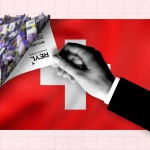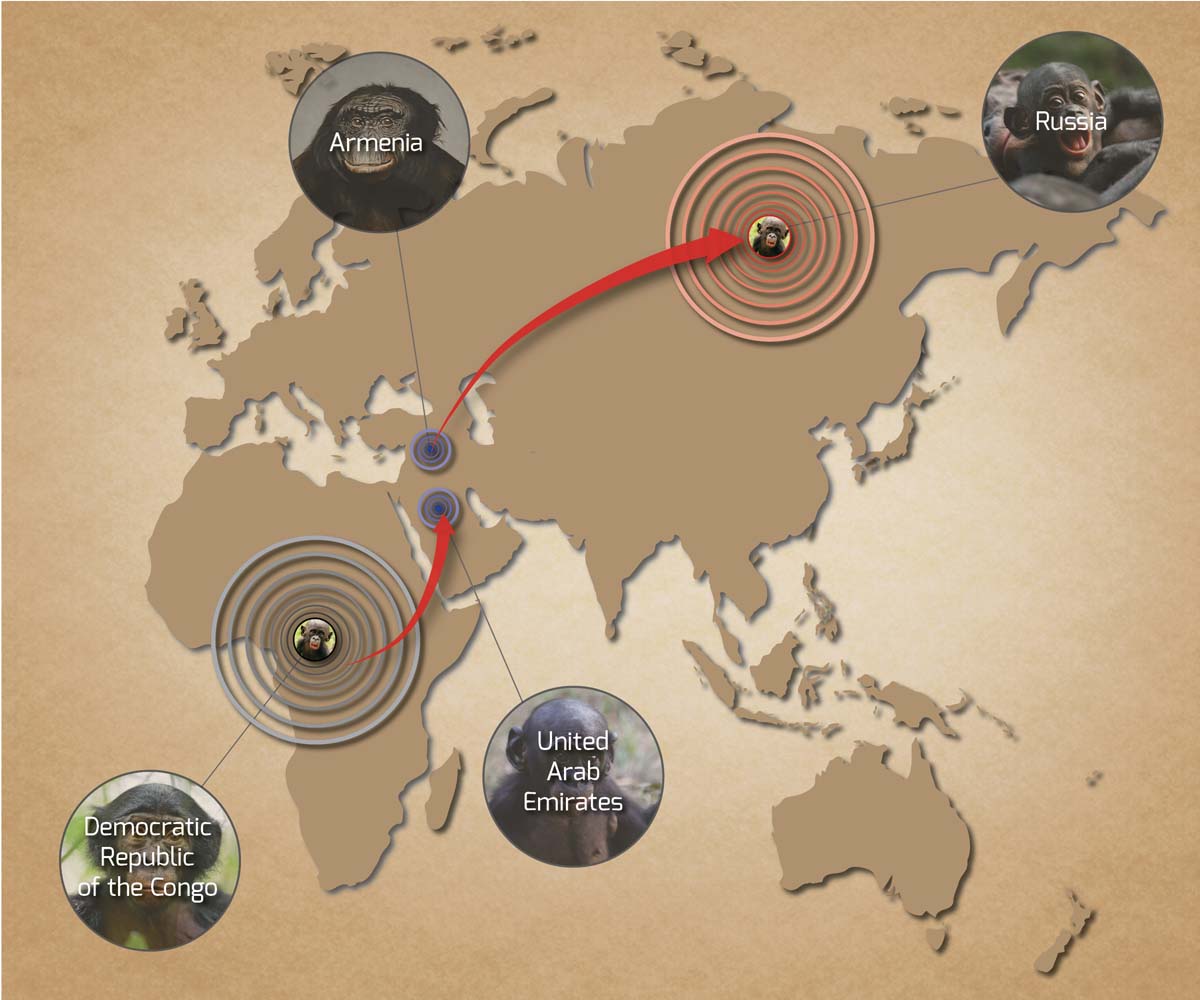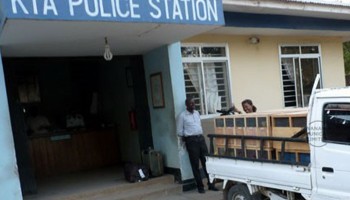The animal—a bonobo from the Democratic Republic of the Congo (DRC)—is an endangered species, and trade in such creatures is supposed to be strictly controlled worldwide.
Yet rare primates and other endangered animal species are being trafficked through Armenia, and since the country’s import-export data often shows no signs of the transactions, there’s no sure way of knowing how many animals are involved or where they are going.
One arm of the government is trying to get to the bottom of this illegal trade and has launched a criminal investigation into animal imports. Yet a second agency—the one actually tasked with protecting endangered animals--says there’s no such problem in Armenia and that all of the paperwork is in order.
Armenia is not the only country where confusing regulations and lax enforcement is making it possible for people to make serious money by buying and selling animals that should be protected.
Sales of endangered animals worldwide bring in as much as US$ 20 billion per year, which would make it the globe’s fourth most profitable illegal business, after drug trafficking, human trafficking and fraud.
Some of the animals brought to Armenia remain in the country. They are used as attractions by various businesses to pull in customers. Some wind up as pets in the homes of Armenia's rich. Others may be ending up in zoos or private collections in Russia.
Consider the bonobo (Pan Paniscus), an ape that resembles a chimpanzee and is sometimes called a pygmy chimpanzee. It shares 98.5 percent of the DNA of a human being.
Native to the Congo River basin in the Democratic Republic of the Congo (DRC), the species has been listed as endangered on the International Union for Conservation of Nature (IUCN) Red List since 1996.
Threatened by poaching and habitat destruction, the bonobo population is estimated to be less than 100,000 and falling fast. The IUCN has adopted a conservation strategy for preserving the bonobo, and its sale and export is banned in the DRC.
Yet somehow a bonobo wound up in an “exotic park” in Armenia, part of a restaurant complex that opened in September of 2012. The complex is the work of Artyom Vardanyan, a businessman who likes to show off the rare animals in his collection.
How did the bonobo get into Armenia?
Illegal poaching is the main reason for the bonobo’s endangered status. The civil wars that wracked the DCR in the 1990s and the collapse of conservation oversight encouraged more organized poaching.
Rare and endangered animals do have some legal protections. In 2009, Armenia signed the 1973 Convention on International Trade in Endangered Species of Wild Fauna and Flora (CITES) , which forbids all trade in bonobos caught in the wild.
Any transaction involving a bonobo is supposed to generate a clear document trail of permissions and permits, but tracking Armenia’s bonobo from Africa to Dzoragbyur proved far from easy.
The Bio-Resources Management Agency at Armenia’s Ministry of Nature Protection (MNP) is responsible for seeing that CITES rules are followed. OCCRP’s partner organization in Armenia, www.hetq.am, asked the MNP for a list of animals imported to Armenia that are classified as “endangered” by CITES.
The bonobo wasn’t on the list sent by MNP.
Vardanyan boasted on a local Armenian TV show that he paid a great deal of money for the bonobo: “Such an animal can fetch € 150,000 (US$ 202,000) on the open market. I purchased it and paid a large sum.”
Vardanyan briefly showed Hetq.am a CITES permit for two bobonos listing the country of export as Guinea and the West Africa Zoo as the exporting organization. The document is dated May 4, 2011.
But an employee at Jambo Park said in 2013 that the bonobo was eight months old, which if true means it couldn’t have been imported in 2011. In addition, inquiries by Hetq.am have failed to find any evidence than any zoo called West Africa Zoo exists in Guinea.
When questioned again later about this discrepancy, Vardanyan said that he hadn’t actually purchased the animal, but had “leased” it from importer Artur Khachatryan.
Artur Khachatryan is the founder and sole owner of Zoo Fauna Art, a company which imports and exports animals via a network that covers Russia, the United Arab Emirates (UAE) and other countries. He has been named as a suspect and given testimony in an ongoing Ministry of Finance criminal investigation into his animal imports, but has yet to be charged .
Khachatryan purchased a large tract of land adjacent to the Erebouni Preserve-Museum just outside Yerevan and is building a zoo. He likes to refer to himself in the third person, and says: “Mr. Khachatryan is building the biggest zoo in all of Eastern Europe.” He’s currently raising animals there and keeping animals he has imported and plans to later export.
Asked about the bonobo, he said, “These monkeys have been legally imported. I know the CITES convention back and forth by heart. You are mistaken.”
Khachatryan refuses to show documents or allow photos or videos to be taken at his zoo site. He did say that he imported not one but two bonobos from Guinea in 2011. He said one was the animal that had been on display at Jambo Park, and that the second arrived in Armenia in poor condition and died after one week.
He claims that the surviving bonobo wasn’t taken from the wild, but was bred in captivity. He said CITES regulations state that an animal bred in captivity can be exported if it will be taken to a zoo.
Khachatryan’s explanation is backed up by Artashes Ziroyan from the MNP’s Bio-Resources Management Agency, who is the CITES mission representative in Armenia. Ziroyan says such animals do not have to appear on the list of imported animals.
But such animals do need a CITES import permit, which then must be listed in CITES’ annual global trade database.
That CITES global database on trade of endangered species of wild fauna and flora has no information on a bonobo ever being exported from Guinea to Armenia. Regulations say a bonobo should also have a permit from the local CITES agency. A chart shows all animals exported from Guinea to Armenia in 2011.
There are no pan paniscus listed.
In response to a Hetq.am inquiry, the Ministry of Finance stated that according to evidence presented in the preliminary phase of the criminal case, the bonobos imported to Armenia by Khachatryan in 2011 were purchased at an animal market in Sharja, UAE.
Khachatryan testified that when he purchased the animals, he was told by representatives of a seller that identified itself as the West Africa Zoo that the bonobos suffered from heart defects.
Believing a veterinarian could nurse the animals back to health, Khachatryan bought them. Under the purchase agreement, West Africa Zoo was to transport the bonobos from Guinea to the UAE. From there, the cargo company Globe Trotters was to ship the animals to Khachatryan. The animals reached Armenia on May 11, 2011.
Khachatryan testified that two months after receiving the bonobos, one died at his zoo. (In an earlier conversation with Hetq.am, Khachatryan said the animal died one week after reaching Armenia). He said he temporarily loaned the other bonobo to Jambo Park owner Artyom Vardanyan.
Guinea a source of falsified permits
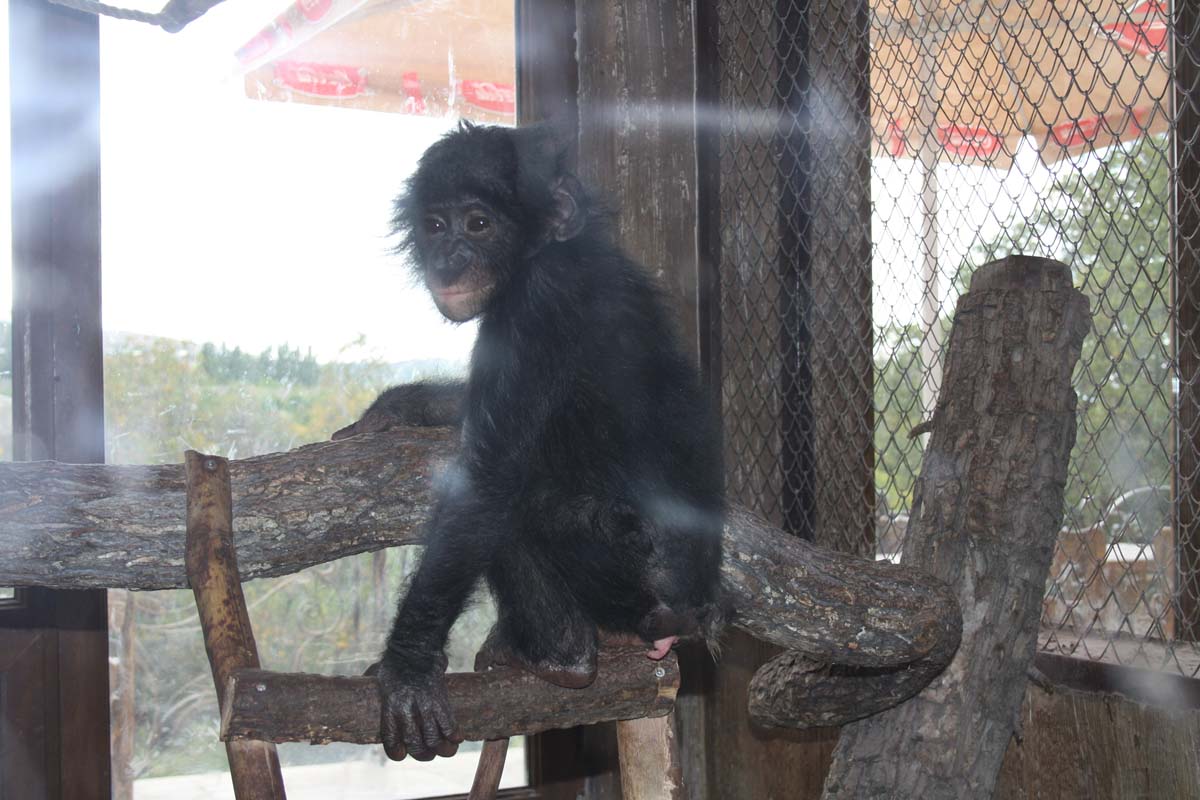 A 2013 report jointly published by the United Nations Environment Program and UNESCO entitled Stolen Apes: The Illicit Trade in Chimpanzees, Gorillas, Bonobos and Orangutans states that Guinea has granted falsified permits .
A 2013 report jointly published by the United Nations Environment Program and UNESCO entitled Stolen Apes: The Illicit Trade in Chimpanzees, Gorillas, Bonobos and Orangutans states that Guinea has granted falsified permits .
In 2007, Guinea exported a large number of chimpanzees to China with CITES permits stating that the animals had been raised in captivity and not captured in the wild. The CITES secretariat sent a mission to Guinea and discovered that in 2010 alone, 69 chimps had been exported from Guinea, destined for Chinese zoos and safari parks.
Yet no legal breeding farms exist in Guinea.
Investigations by non-profits and individuals reveal that at least 138 chimps and 10 gorillas have been exported to China in this manner. Investigators suspect the animals were actually transported through nearby countries including Cameroon, the Ivory Coast, the DRC and Libya, and were all captured in the wild.
Bonobos aren’t the only endangered animals being imported
While neither the MNP nor the African officials seem able to say much about the bonobos, Armenian tax authorities can shed some light on the importation of threatened species.
The State Revenue Committee (SRC) is responsible for tracking all imports and exports, both taxable and non-taxable. Its records show that four bonobos were imported into Armenia, two in 2011 and two more in 2012.
According to a list provided by Artur Afrikyan, First Deputy to the President at the SRC, at least a dozen protected animals that entered Armenia between 2010-13 required CITES permits.
In addition to the four bonobos, the SRC list includes four Common Chimpanzees (Pan troglodytes) and four Diana Monkeys (Cercopithecus Diana), which were imported to Armenia in 2010. The list shows Guinea as the country of origin for the animals, which were imported through the UAE. These animals are also found on the IUCN Red List of Threatened Species.
Yet the MNP told Hetq.am that it has never issued permits to import bonobos, Common Chimpanzees or Diana Monkeys to Armenia, and the CITES database contains no information about such animals being exported from the UAE to Armenia.
These animals should still be in Armenia, since they aren’t on any export lists or on any lists seeking permits to export. But the Ministry of Nature Protection has no clue where these animals are now.
Ziroyan, the CITES mission representative in Armenia, says he does not know which endangered species are entering the country, nor does he track the fate of the animals that do arrive, or the permits involved when animals are imported or exported.
But he says his agency "brilliantly" meets the CITES criteria, and that no permissions were issued for import or export of these animals “(because) they are not from the wild and that's all."
Ziroyan said he hasn’t visited the animals in Jambo Park or checked if the owner had proper permissions. "No, I don't have the right," he said, adding that his agency hasn't seen any documents.
Bonobos are not the only primates Zoo Fauna Art has imported.
Hetq.am has obtained a CITES permit showing the organization brought 30 monkeys into Armenia in 2013 from the Democratic Republic of Congo: 10 mangabeys, 10 talapoins, and 10 agile mangabeys. These three species are classified by CITES as not now in threat of extinction, but they may become so unless trade is closely controlled.
The CITES permit is not dated, which is required by law .
In an attempt to certify whether the proper governmental body in the DRC actually issued the permit, Hetq.am contacted Leonard Muamba Kanda, whose name appears on the permit as CITES Chef de Service in Kinshasa.
“I believe that to date no mangabey-type animals have been officially exported to Armenia,” was Kanda’s initial response. A second written correspondence to Kanda included a copy of the permit for the monkeys, and asked if the signature appearing was his.
“The signature on the document isn’t dated. Please wait until I return to Kinshasa. I will look into the matter and inform you,” was Kanda’s response. When he did respond, he did not deny that it was an authentic permit, but offered no explanation for why the permit wasn’t dated.
At least 36 monkeys belonging to these three species were imported into Armenia in 2013, but the date on that permit is suspect. The permit was issued in December 2013, yet expires on June 30, 2013 -- six months before it was issued .
The CITES Secretariat based in Geneva has investigated and uncovered a number of false import/export permits issued by the Democratic Republic of the Congo. The Secretariat has published a list of fake or falsified permits apparently issued in the DRC that includes the abovementioned permits for the import of animals to Armenia.
The DRC’s CITES mission says that a large number of permits were either lost or stolen from their files, and thus they could not clarify the matter.
Interpol is looking into Armenia’s importation of bonobos. The DRC’s Interpol branch has contacted colleagues in Armenia to ascertain how the bonobo wound up in Jambo Park.
Ara Fidanyan, who heads Interpol’s Armenia bureau, told Hetq.am that his office first heard about the import of two bonobos in August 2013 from their DRC colleagues. Fidanyan says he passed the information on to Armenian law enforcement agencies and the criminal investigation was launched.
“This is the first time we’ve received information from our colleagues overseas about an Armenian connection in the trade of endangered animals,” Fidanyan said. “Hopefully, after this investigation, we will have information about other such cases.”
Jambo Park’s Vardanyan owns many rare animals
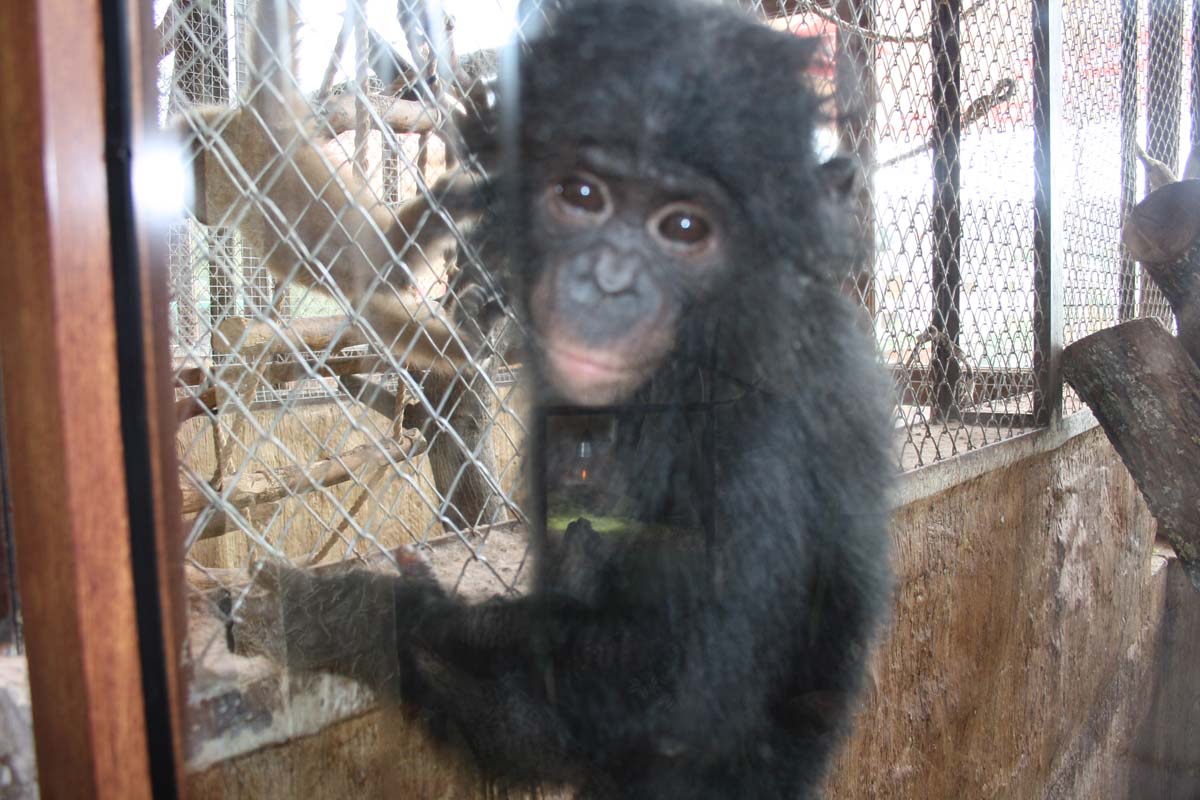 Many of the monkey species exhibited at Jambo Park can’t be found even in the Yerevan State Zoo. Artyom Vardanyan says that he owns 75 monkeys including chimps, mangabeys, mandrills, and others. There are also rare bird species like a black cockatoo on display.
Many of the monkey species exhibited at Jambo Park can’t be found even in the Yerevan State Zoo. Artyom Vardanyan says that he owns 75 monkeys including chimps, mangabeys, mandrills, and others. There are also rare bird species like a black cockatoo on display.
Vardanyan told Hetq.am that he obtained some of his animals from Edvard Khachatryan, a friend in the animal trade in Russia who has built his own “exotic park” not far from Moscow.
Edvard Khachatryan is an Armenian born in Tbilisi, Georgia. According to the Russian State Registry of Individual Business Owners, Khachatryan oversees a farming enterprise that produces meat, dairy products, livestock feed, consumer beverages and food preserves. He also raises livestock and runs an operation that hunts and collects wild animals.
Hetq.am visited his “exotic park” outside Moscow in June. His zoo resembled an animal sanctuary; many cages were closed from public view and only a few animals were on exhibit, including an orangutan, an endangered species.
The park opened in 2012. In photos taken at the opening and available on social media, one can see a newborn chimpanzee. It wasn’t at the zoo when Hetq.am visited. A park employee told Hetq.am the chimp had been removed, but he didn’t know to where.
When Hetq.am telephoned Khachatryan to set up a meeting, he declined. He did say his animals hadn’t been imported from Armenia, but from various European countries. He said it is not a matter for journalists to investigate.
Swiss investigative reporter Karl Ammann, who lives in Kenya and has produced films for German ZDF TV on the illegal animal trade, says that obtaining endangered animals is difficult and expensive.
He said a pair of African chimpanzees might cost between $10,000 and $15,000. A pair of bonobos might cost between $15,000 and $20,000. Prices for animals CITES classifies as not immediately threatened with extinction but in need of protection range from $1,000 to $3,000. But Ammann says prices jump several-fold when the animals are resold.
According to the National Statistical Service of Armenia, 286 primates were imported in 2011 and 133 in 2012. Most came originally from the DRC, Tanzania, Mali and Guinea, by way of the UAE. The majority were then exported on to Russia.
As for the bonobo at Jambo Park, Vardanyan claimed in testimony that it died from an illness in December 2013. The death has been certified by a physician’s affidavit.

